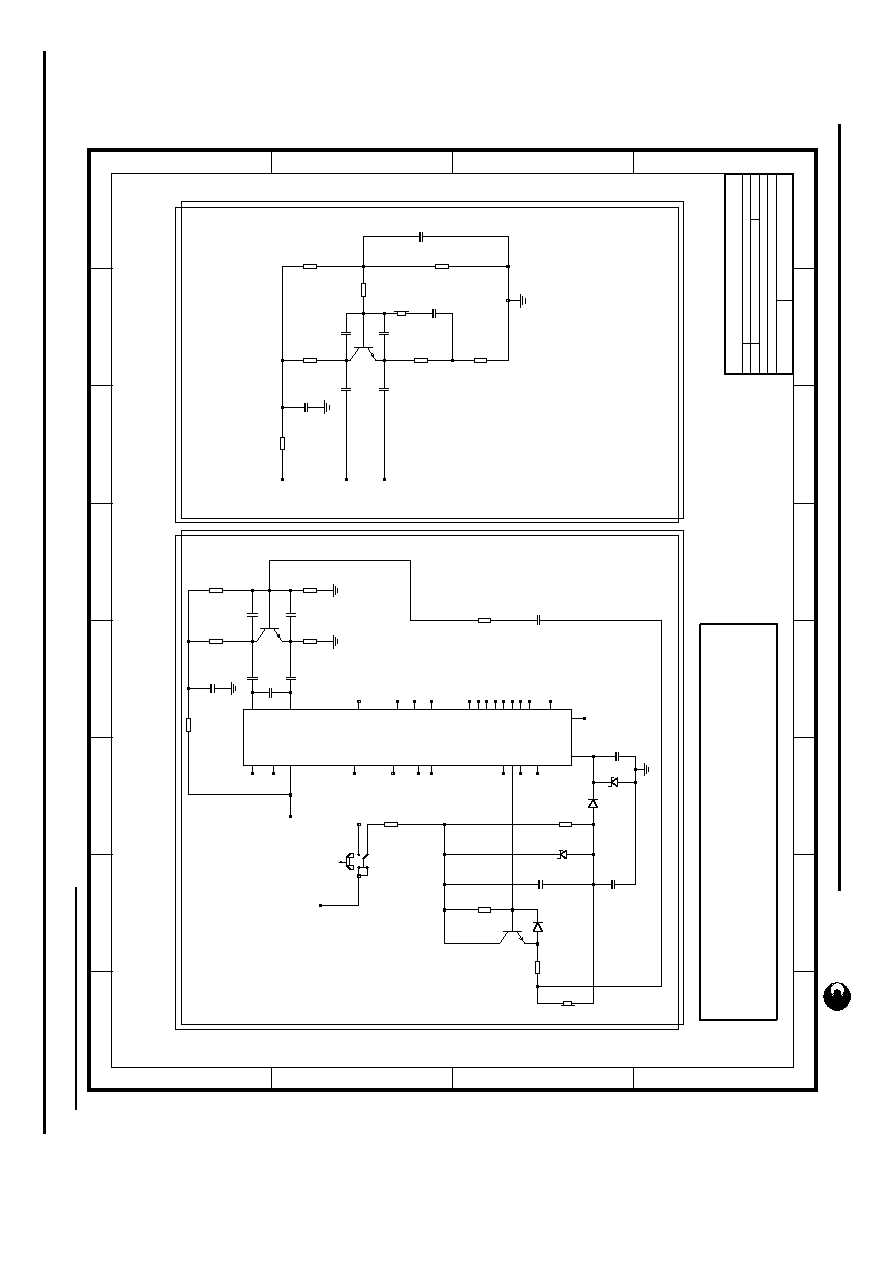 | –≠–ª–µ–∫—Ç—Ä–æ–Ω–Ω—ã–π –∫–æ–º–ø–æ–Ω–µ–Ω—Ç: SAN3021 | –°–∫–∞—á–∞—Ç—å:  PDF PDF  ZIP ZIP |

SAN3021
PDS038-SA2531/2-004 Rev. B 21-03-00
This Application Note describes how to modify the standard application AN1500A to use a dynamic microphone
instead of the standard electret microphone. Additionally, an application is shown, which uses the dynamic
microphone as tone ringer.
∑
Updating existing systems using dynamic handset microphone
∑
No need for a piezo ringer when using the dynamic microphone as tone ringer
Table of Contents
1
SCOPE................................................................................................................................................................. 1
2
KEY FEATURES ................................................................................................................................................. 1
3
OTHER APPLICABLE DOCUMENTS AND PAPERS ........................................................................................ 1
4
REVISION STATUS............................................................................................................................................. 1
5
GENERAL DESCRIPTION .................................................................................................................................. 2
6
HARDWARE CONFIGURATION......................................................................................................................... 2
6.1
U
SING THE DYNAMIC MICROPHONE AS TONE RINGER
(
SCHEMATIC
:
A
)................................................................. 2
6.1.1
Ringer part ............................................................................................................................................. 2
6.1.2
Microphone amplifier part ...................................................................................................................... 3
6.2
A
MPLIFIER FOR GENERAL PURPOSE APPLICATIONS
(
SCHEMATIC
:
B
) ................................................................... 3
7 APPLICATION SCHEMATIC:............................................................................................................................. 4
8
LIABILITY AND COPYRIGHT STATEMENT...................................................................................................... 5
Application Note AN1500A: SA2532K Single Chip Telephone Demo Board
SAN3021 Application Note (this document)
SAN3021 Schematic
Rev. 1.1
sames
sames
sames
sames
SA2531/2 Single Chip Telephone:
Using dynamic microphone
as tone ringer
SAN3021
APPLICATION NOTE
1 Scope
2 Key Features
3 Other applicable documents and papers
4 Revision status

SAN3021
2/5
sames
sames
sames
sames
Dynamic handset microphones have been widely replaced by electret microphones, mainly because of higher
output level, low EMC sensitivity and price issues. Therefore, the standard Single Chip Telephone application,
AN1500 is based on using an electret handset microphone.
However, there are situations where usage of a dynamic microphone is still desired, e.g.
∑
when updating an existing design , using a dynamic handset microphone
∑
when taking advantage of the higher speech quality of dynamic microphones
∑
when using the dynamic microphone as tone ringer
Generally, because of the lower output level of a dynamic microphone (
10dB less than an electret microphone)
the microphone signal must be amplified by a simple 10dB amplifier before it can be fed into the microphone
inputs, M1 and M2 of the SA2531/2.
In the following schematic, two basic considerations when using dynamic microphones are shown:
1. A single ended circuit, which uses the dynamic microphone for both microphone and tone ringer.
2. A differential circuit, which is fully balanced, to replace an electret microphone.
6.1 Using the Dynamic Microphone as Tone Ringer (Schematic :A)
6.1.1 Ringer part
The piezo tone ringer used in AN1500 can be replaced by a dynamic microphone, when close attention is paid to
the following considerations :
Since a maximum sound pressure is required in ringing mode, the maximum DC current and AC level
for the type of dynamic microphone used must not be exceeded.
To limit the output of the ringer amplifier Q4, the zener diode D4 should be reduced to 15V . R18 limits the output
current, it can also be used to set the ringer volume.
Since the microphone (= the ringer) is connected single ended to V
DD
, any noise on V
DD
would be amplified by the
microphone amplifier, causing higher noise for the transmitted signal. Therefore, D6 and C10 are added to
reference the microphone amplifier input to V
SS
(over C10) but at the same time keep the DC level above V
DD
in
ringing mode.
The ringer cannot be referenced to V
SS
, because it would discharge V
DD
during ringing!
With the application shown, the anode of D6 will be V
DD
+0.7V, because during ringing V
DD
is supplied over the
ringing capacitor. (not shown).
5 General description
6 Hardware configuration

SAN3021
3/5
sames
sames
sames
sames
6.1.2 Microphone Amplifier
Q5 is a simple "classic" amplifier, which amplifies the single ended signal by
10dB. Gain can be adjusted by
varying R21. R23 is the feedback resistor to set a stable DC bias point. R24 and R25 are setting the base voltage.
The transistor type used (in this case BC549) should be a general purpose low noise transistor.
The single ended signal is decoupled by C17. R26 is required to limit the input current to the amplifier during
ringing.
C15 and C16 are EMC capacitors to limit the bandwidth of the amplifier. Frequencies >10kHz are being attenuated.
The amplifier is supplied by (the initial electret microphone supply) R20 and C14. C14 should be increased to
220µF. Since this supply is derived from the line output, there will be some small ripple from the transmitted signal
at C14.
In order not to form a positive feedback loop from LI over the microphone supply, Q5 and the internal microphone
amplifier (M1/M2 to LI) , care must be taken to connect M1/M2 inputs in the correct manner as shown in the
application.
With this connection, a negative feedback loop is formed, rejecting any ripple on C14.
Because of the unbalanced, single ended structure of this amplifier, its input is very sensitive. Therefore it
is recommended to use this application only in one-piece telephones with shortest possible wires
between microphone and amplifier !
6.2 Amplifier for General Purpose Applications (Schematic :B)
This amplifier is similar to the amplifier described in pt. 6.1, however the microphone is balanced (RR23B and
RR26 = 2k
).
Amplifier gain = RR21 / RR23B = 3:1 = 10dB.
This application can directly replace an electret microphone. Because of the differential, balanced structure of the
amplifier input , it is also suitable for longer distances between microphone and amplifier, e.g. corded handsets.

SAN3021
4/5
sames
sames
sames
sames
7 Application schematic:
1
2
3
4
5
6
7
8
1
2
3
4
5
6
7
8
A
B
C
D
A
B
C
D
The information furnished here by SAMES is believed to be correct and accurate. However, SAMES shall not
be held liable to any party for any damages including but not limited to personal injury, property damage, loss of
profits, loss of use, interuption of business or indirect, special, incidental or consequential damages, of any kind,
in connection with or arising out of the furnishing, performance or use of the technical data. No obligation or
liability to any third party shall arise or flow out of SAMES rendering technical or other services.
MIC
MIC
VDD
VSS
OSC
R4
R3
R2
R1
C4
C3
C2
C1
HS/DP
MO
MODE
LLC
SA2531/2
CS
CI
RR
AGND
RO2
STB
RO1
RI
LI
FCI
LS
M2
M1
IC1
SAMES Telecom
3rd March 1997
Date :
of
Single Chip Telephone Application Circuit
Rev :
Sch.
Sh
Pn#
SAN3021
01
01
off
on
7
5
6
8
SW1_b
Q6
BC549
Q5
BC549
Q4
BC 547B
D4
15V
D11
5V6
+
CC17
10U
+
CC18
10U
+
CC14
100u/25V
+
C8
10u/25V
+
C10
10u/16V
+
C9
470u/16V
+
C14
220u/25V
D6
1N4148
D5
1N4148
CC13
100N
CC11
100N
CC15
1N
CC19
1N
C13
100N
C15
1N
C16
1N
C11
100N
C12
X
C17
10n
RR23A
1K
RR23B
2K
RR25
12K
RR26
1K1
RR24
27K
RR21
3K
RR20
2K2
R25
110K
R24
360K
R21
6..10K
R20
2K2
R23
2K
R26
1K1
R17
100K
R15
330K
R18
>=0
R7
220K
M2
M1
LI
Applications Using Dynamic Handset Microphone
in one-piece telephones.
applications.
B. Amplifier for general
23
24
27
microphone as ringer
A. Using dynamic handset
27
3
2
23
24
5
16
15
14
13
20
19
18
17
12
11
26
4
9
22
8
10
7
25
6
28
1
21
1.1

SAN3021
5/5
sames
sames
sames
sames
Disclaimer:
The information contained in this document is confidential and proprietary to South African
Micro-Electronic Systems (Pty) Ltd ("SAMES") and may not be copied or disclosed to a third party, in whole or in
part, without the express written consent of SAMES. The information contained herein is current as of the date of
publication; however, delivery of this document shall not under any circumstances create any implication that the
information contained herein is correct as of any time subsequent to such date. SAMES does not undertake to
inform any recipient of this document of any changes in the information contained herein, and SAMES expressly
reserves the right to make changes in such information, without notification,even if such changes would render
information contained herein inaccurate or incomplete. SAMES makes no representation or warranty that any
circuit designed by reference to the information contained herein, will function without errors and as intended by the
designer
.
South African Micro-Electronic Systems (Pty) Ltd
P O Box 15888,
33 Eland Street,
Lynn East,
Koedoespoort Industrial Area,
0039
Pretoria,
Republic of South Africa,
Republic of South Africa
Tel:
012 333-6021
Tel:
Int +27 12 333-6021
Fax:
012 333-3158
Fax:
Int +27 12 333-3158
Web Site : http://www.sames.co.za
8 Liability and Copyright Statement




